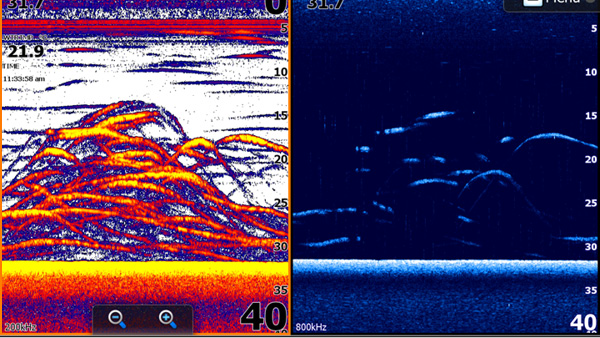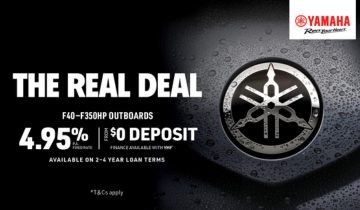Dean Silvester talks about how he uses StructureScan and standard sonar. These have different features and can be used in different circumstances.

There are two types of transducers to run with your sounder: standard sonar and StructureScan. I often get asked which one is better than the other. I run both as there are reasons for requiring both types of information at certain times.
I run an 83/200 transducer for my standard sonar. I like to have it set on 200 with the auto sensitivity at plus 2 depending on the water clarity, oxygen levels and a few other factors. This is my searching tool, I use this with a fairly quick idle speed on my boat utilising a split screen with Insight Genesis map and the standard sonar screen idling around the drop offs and points searching for fish, bait schools or structure.
Once I locate an area of interest, I will slow down and cover the area to work out what is holding in the vicinity. Once fish is located, I use the standard sonar to help me understand the mood of the fish as well as amount and I am often able to tell the quality. The denser the yellow in the centre of the fish the bigger the fish typically are, if you have one, two or three fish actively moving around in a range of 3 – 5 feet you know they are catchable. If there are a lot more lines and they are fairly horizontal and grouped tightly it is fair to assume they are shut down.

Yellowbelly, bass and catfish show up significantly different on the colour spectrum and intensity on the standard sonar. This is very important information to me in a tournament situation. Catfish will sit very tight to each other looking as if they are almost synchronised, the lines are thin and tightly bunched and the tell-tale is that they will be excited by the transducer pulse and rise up beneath the boat. I need to determine the species of fish quickly so that I don’t waste valuable time.
Once I find a concentration of fish that I want to check out further, I will split the screen between sonar and StructureScan then continue to sound around. Using the StructureScan, I can now determine how tight the fish are to structure, what the bottom composition looks like as well as clearly identify items of structure on the bottom.


One of the key uses for StructureScan is determining the size of the fish, the bass will sit separately on the screen and I can tell a big fish from a good one and or an undersized fish. The slight variation in shape of fish often enables me to determine the species ie catfish over bass etc. It is very easy to identify the size of the fish on StructureScan with the fish being separate symbols even when densely schooled this then allows me to target the biggest of the fish. In most circumstances the bigger fish will either sit above or below the smaller ones. With StructureScan, I can determine the depth of the bigger ones and adjust my lure to suit and best maximise my chances of catching that kicker fish.







